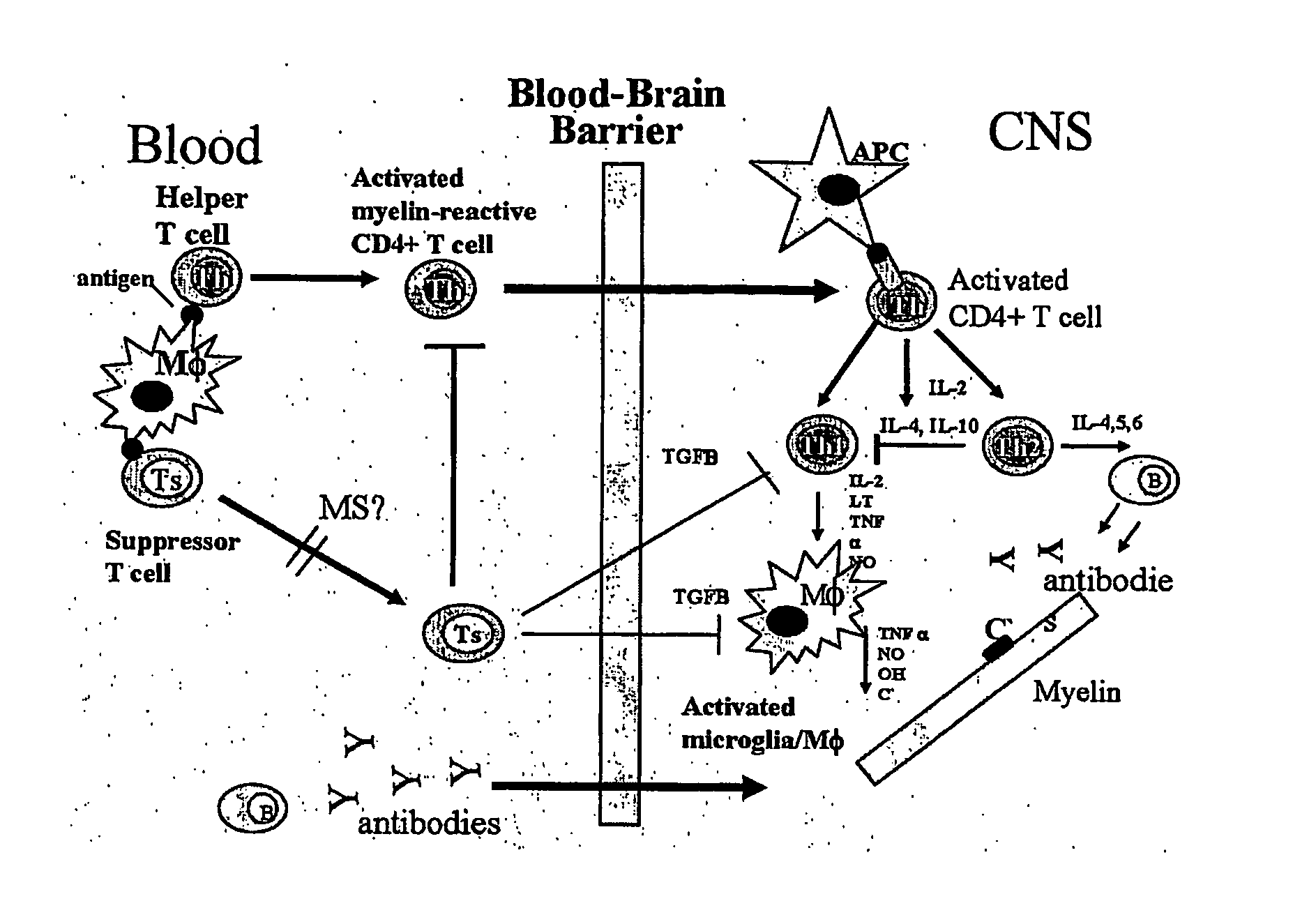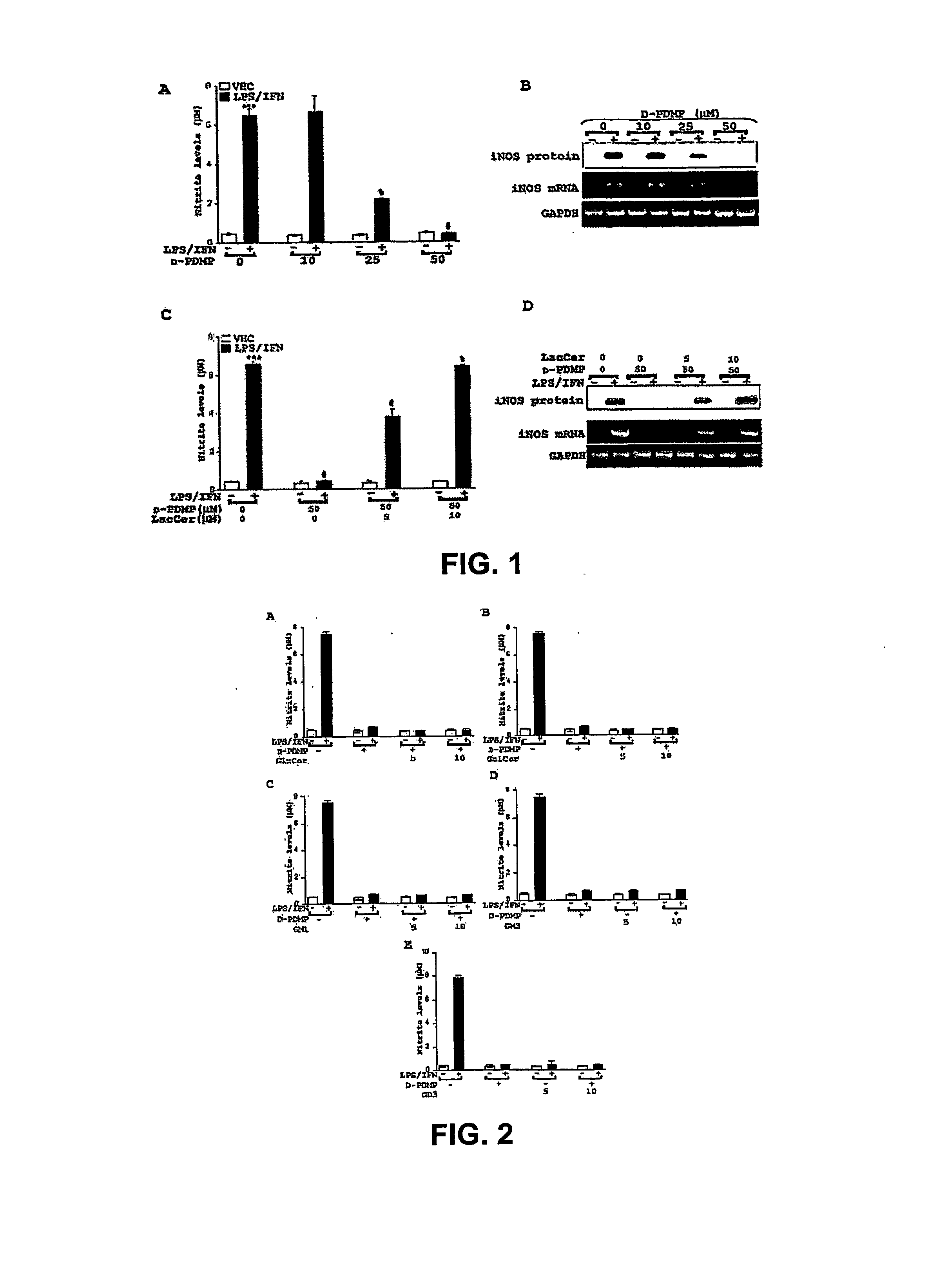Methods and Compositions for the Prevention and Treatment of Inflammatory Diseases or Conditions
- Summary
- Abstract
- Description
- Claims
- Application Information
AI Technical Summary
Benefits of technology
Problems solved by technology
Method used
Image
Examples
example 1
Material and Methods I
[0135] Reagents. Recombinant rat interferon gamma (IFN and antibody against mouse macrophage iNOS was obtained from Calbiochem (CA). DMEM and FBS were from Life Technologies Inc. Lipopolysaccharide, (from Escherichia coli Serotype 0111:B4) was from Sigma (MO). Glucosylceramide, lactosylceramide, galactosylceramide, gangliosides and D-PDMP (C23H38N2O3.HCl; D-threo-1-Phenyl-2-decanoylamino-3-morpholino-1-propanol.HCl) were from Matreya Inc (PA). 14C-Galactose and 3HUDP-Galactose was obtained from American Radiolabeled Chemicals (MO).
[0136] Cell Culture. Primary astrocyte-enriched cultures were prepared from the whole cortex of 1-day-old Sprague-Dawley rats as described earlier (Pahan et al., 1998). Briefly, the cortex was rapidly dissected in ice-cold calcium / magnesium free Hanks Balanced Salt Solution (HBSS) (Gibco, Grand Island, N.Y.) at pH 7.4 as described previously (Won et al., 2001). The tissue was then minced, incubated in HBSS containing trypsin (2 mg / ...
example 2
Results I
[0155] LPS / IFN -induced NO production and iNOS gene expression is mediated by GSLs. LPS / IFN stimulation of primary astrocytes resulting in iNOS gene expression is a complex multi-step process. The present study tested whether GSLs were somehow involved. Primary astrocytes pretreated for 0.5 h with several concentrations of the glycosphingolipid inhibitor D-PDMP (0, 10, 25 and 50 M) followed by stimulation with LPS / IFN (1 g / ml; 10 U / ml) showed a dose dependent decrease in production of nitric oxide (NO) (FIG. 1A) as well as mRNA and protein levels of iNOS (FIG. 1B). However, in the presence of increasing doses of LacCer, D-PDMP mediated inhibition of NO production (FIG. 1C) and iNOS gene expression (FIG. 1D) was blunted. To prove that this was a LacCer specific effect, other glycosphingolipid derivatives were also exogenously supplemented. However, the presence of Glucer (FIG. 2A), GalCer (FIG. 2B) and the various gangliosides-GM1 (FIG. 2C), GM3 (FIG. 2D) and GD3 (FIG. 2E...
example 3
Discussion I
[0162] Nitric-oxide mediated pathophysiology is common to a number of neuroinflammatory diseases including stroke and spinal cord injury (SCI). As it is not completely known which factors induce and regulate iNOS gene expression in inflammatory disease, in this study the involvement of glycosphingolipids and demonstrated a novel pathway of iNOS gene regulation through LacCer mediated events involving Ras / ERK1 / 2 and the I -B / NF- B pathway in primary astrocytes has been investigated. These conclusions are based on the following findings. (1) LPS / IFN induced iNOS gene expression and LacCer production was inhibited by D-PDMP, a glycosphingolipid synthesis inhibitor. The addition of exogenous lactosylceramide, and not any other glycosphingolipid, reversed the inhibition of iNOS gene expression by D-PDMP. (2) LPS / IFN stimulated GalT-2 activity within 5 minutes and rapidly increased the levels of intracellular lactosylceramide. Furthermore, knockdown of GalT-2 using antisens...
PUM
| Property | Measurement | Unit |
|---|---|---|
| Pharmaceutically acceptable | aaaaa | aaaaa |
Abstract
Description
Claims
Application Information
 Login to View More
Login to View More - R&D
- Intellectual Property
- Life Sciences
- Materials
- Tech Scout
- Unparalleled Data Quality
- Higher Quality Content
- 60% Fewer Hallucinations
Browse by: Latest US Patents, China's latest patents, Technical Efficacy Thesaurus, Application Domain, Technology Topic, Popular Technical Reports.
© 2025 PatSnap. All rights reserved.Legal|Privacy policy|Modern Slavery Act Transparency Statement|Sitemap|About US| Contact US: help@patsnap.com



